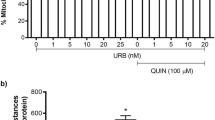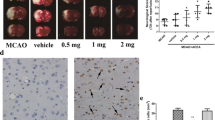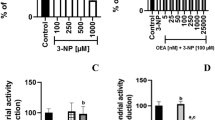Abstract
2-Arachidonoylglicerol (2-AG) is an endocannabinoid that mimics the pharmacological effects of Δ9 tetrahydrocannabinol, the psychoactive component of the plant Cannabis sativa. It is present in many mammalian tissues, such as brain, liver, spleen, heart and kidney, where it exerts different biological effects either receptor mediated or independently of receptor activation. This work analyzes the effects of 2-AG on liver mitochondrial functions. It is shown that 2-AG causes a relevant decrease of calcium induced cyclosporine A sensitive cytochrome c release from mitochondria, a process representing an early event of the apoptotic program. Cyclosporin sensitive matrix swelling and ROS production measured under the same conditions are, on the contrary, almost unaffected or even enhanced, respectively, by 2-AG. Furthemore, 2-AG is found to stimulate resting state succinate oxidase activity and to inhibit oligomycin sensitive FoF1 ATP synthase activity. All these effects are apparently associated with 2-AG dependent alteration in the fluidity of the mitochondrial membranes, which was measured as generalized polarization of laurdan fluorescence.
Similar content being viewed by others
References
Andreyev A, Fiskum G (1999) Calcium induced release of mitochondrial cytochrome c by different mechanisms selective for brain versus liver. Cell Death Differ 6(9):825–832. doi:10.1038/sj.cdd.4400565
Basavarajappa BS (2007) Critical enzymes involved in endocannabinoid metabolism. Protein Pept Lett 14(3):237–246
Bisogno T, Howell F, Williams G, Minassi A, Cascio MG, Ligresti A et al (2003) Cloning of the first sn1-DAG lipases points to the spatial and temporal regulation of endocannabinoid signaling in the brain. J Cell Biol 163(3):463–468. doi:10.1083/jcb.200305129
Broekemeier KM, Dempsey ME, Pfeiffer DR (1989) Cyclosporin A is a potent inhibitor of the inner membrane permeability transition in liver mitochondria. J Biol Chem 264(14):7826–7830
Brown AJ (2007) Novel cannabinoid receptors. Br J Pharmacol 152(5):567–575. doi:10.1038/sj.bjp. 0707481
Catanzaro G, Rapino C, Oddi S, Maccarrone M (2009) Anandamide increases swelling and reduces calcium sensitivity of mitochondria. Biochem Biophys Res Commun 388(2):439–442. doi:10.1016/j.bbrc.2009.08.037
Chan KM, Junger KD (1984) The effect of streptozocin-induced diabetes on the plasma membrane calcium uptake activity of rat liver. Diabetes 33(11):1072–1077
Crompton M, Ellinger H, Costi A (1988) Inhibition by cyclosporin A of a Ca2+ −dependent pore in heart mitochondria activated by inorganic phosphate and oxidative stress. Biochem J 255(1):357–360
Devane WA, Dysarz FA 3rd, Johnson MR, Melvin LS, Howlett AC (1988) Determination and characterization of a cannabinoid receptor in rat brain. Mol Pharmacol 34(5):605–613
Di Marzo V (1998) ‘Endocannabinoids’ and other fatty acid derivatives with cannabimimetic properties: biochemistry and possible physiopathological relevance. Biochim Biophys Acta 1392(2–3):153–175
Di Marzo V, Petrocellis LD (2006) Plant, synthetic, and endogenous cannabinoids in medicine. Annu Rev Med 57:553–574. doi:10.1146/annurev.med.57.011205.135648
Di Marzo V, Bisogno T, De Petrocellis L, Melck D, Orlando P, Wagner JA et al (1999) Biosynthesis and inactivation of the endocannabinoid 2-arachidonoylglycerol in circulating and tumoral macrophages. Eur J Biochem 264(1):258–267
Di Paola M, Cocco T, Lorusso M (2000) Ceramide interaction with the respiratory chain of heart mitochondria. Biochemistry 39(22):6660–6668
Di Paola M, Zaccagnino P, Oliveros-Celis C, Lorusso M (2006) Arachidonic acid induces specific membrane permeability increase in heart mitochondria. FEBS Lett 580(3):775–781. doi:10.1016/j.febslet.2005.12.090
Franklin A, Parmentier-Batteur S, Walter L, Greenberg DA, Stella N (2003) Palmitoylethanolamide increases after focal cerebral ischemia and potentiates microglial cell motility. J Neurosci 23(21):7767–7775
Gaoni Y, Mechoulam R (1971) The isolation and structure of delta-1-tetrahydrocannabinol and other neutral cannabinoids from hashish. J Am Chem Soc 93(1):217–224
Halestrap AP, Davidson AM (1990) Inhibition of Ca2(+)-induced large-amplitude swelling of liver and heart mitochondria by cyclosporin is probably caused by the inhibitor binding to mitochondrial-matrix peptidyl-prolyl cis-trans isomerase and preventing it interacting with the adenine nucleotide translocase. Biochem J 268(1):153–160
Hansson MJ, Mansson R, Morota S, Uchino H, Kallur T, Sumi T et al (2008) Calcium-induced generation of reactive oxygen species in brain mitochondria is mediated by permeability transition. Free Radic Biol Med 45(3):284–294. doi:S0891-5849(08)00208-6
Ito A, Ogishima T, Ou W, Omura T, Aoyagi H, Lee S et al (1985) Effects of synthetic model peptides resembling the extension peptides of mitochondrial enzyme precursors on import of the precursors into mitochondria. J Biochem 98(6):1571–1582
Izzo AA, Fezza F, Capasso R, Bisogno T, Pinto L, Iuvone T et al (2001) Cannabinoid CB1-receptor mediated regulation of gastrointestinal motility in mice in a model of intestinal inflammation. Br J Pharmacol 134(3):563–570. doi:10.1038/sj.bjp. 0704293
Julien B, Grenard P, Teixeira-Clerc F, Van Nhieu JT, Li L, Karsak M et al (2005) Antifibrogenic role of the cannabinoid receptor CB2 in the liver. Gastroenterology 128(3):742–755
Kano M, Ohno-Shosaku T, Hashimotodani Y, Uchigashima M, Watanabe M (2009) Endocannabinoid-mediated control of synaptic transmission. Physiol Rev 89(1):309–380. doi:10.1152/physrev.00019.2008
Kondo S, Kondo H, Nakane S, Kodaka T, Tokumura A, Waku K et al (1998) 2-Arachidonoylglycerol, an endogenous cannabinoid receptor agonist: identification as one of the major species of monoacylglycerols in various rat tissues, and evidence for its generation through CA2+ −dependent and -independent mechanisms. FEBS Lett 429(2):152–156
Ligresti A, Bisogno T, Matias I, De Petrocellis L, Cascio MG, Cosenza V et al (2003) Possible endocannabinoid control of colorectal cancer growth. Gastroenterology 125(3):677–687
Maciel EN, Vercesi AE, Castilho RF (2001) Oxidative stress in Ca(2+)-induced membrane permeability transition in brain mitochondria. J Neurochem 79(6):1237–1245
Martin BR (1986) Cellular effects of cannabinoids. Pharmacol Rev 38(1):45–74
Matsuda LA, Lolait SJ, Brownstein MJ, Young AC, Bonner TI (1990) Structure of a cannabinoid receptor and functional expression of the cloned cDNA. Nature 346(6284):561–564. doi:10.1038/346561a0
McStay GP, Clarke SJ, Halestrap AP (2002) Role of critical thiol groups on the matrix surface of the adenine nucleotide translocase in the mechanism of the mitochondrial permeability transition pore. Biochem J 367(Pt 2):541–548. doi:10.1042/BJ20011672
Melck D, De Petrocellis L, Orlando P, Bisogno T, Laezza C, Bifulco M et al (2000) Suppression of nerve growth factor Trk receptors and prolactin receptors by endocannabinoids leads to inhibition of human breast and prostate cancer cell proliferation. Endocrinology 141(1):118–126
Mukherjee S, Adams M, Whiteaker K, Daza A, Kage K, Cassar S et al (2004) Species comparison and pharmacological characterization of rat and human CB2 cannabinoid receptors. Eur J Pharmacol 505(1–3):1–9. doi:10.1016/j.ejphar.2004.09.058
Munro S, Thomas KL, Abu-Shaar M (1993) Molecular characterization of a peripheral receptor for cannabinoids. Nature 365(6441):61–65. doi:10.1038/365061a0
Pacher P, Batkai S, Kunos G (2006) The endocannabinoid system as an emerging target of pharmacotherapy. Pharmacol Rev 58(3):389–462. doi:10.1124/pr.58.3.2
Palleschi S, Silvestroni L (1996) Laurdan fluorescence spectroscopy reveals a single liquid-crystalline lipid phase and lack of thermotropic phase transitions in the plasma membrane of living human sperm. Biochim Biophys Acta 1279(2):197–202
Patel SP, Katyare SS (2006a) Effect of alloxan diabetes and subsequent insulin treatment on temperature kinetics properties of succinate oxidase activity in rat kidney mitochondria. J Membr Biol 213(1):31–37. doi:10.1007/s00232-006-0041-2
Patel SP, Katyare SS (2006b) Insulin-status-dependent modulation of FoF1-ATPase activity in rat liver mitochondria. Lipids 41(7):695–703
Pinto L, Izzo AA, Cascio MG, Bisogno T, Hospodar-Scott K, Brown DR et al (2002) Endocannabinoids as physiological regulators of colonic propulsion in mice. Gastroenterology 123(1):227–234
Piomelli D (2005) The endocannabinoid system: a drug discovery perspective. Curr Opin Investig Drugs 6(7):672–679
Ryberg E, Larsson N, Sjogren S, Hjorth S, Hermansson NO, Leonova J et al (2007) The orphan receptor GPR55 is a novel cannabinoid receptor. Br J Pharmacol 152(7):1092–1101. doi:10.1038/sj.bjp. 0707460
Schmid PC, Schwartz KD, Smith CN, Krebsbach RJ, Berdyshev EV, Schmid HH (2000) A sensitive endocannabinoid assay. The simultaneous analysis of N-acylethanolamines and 2-monoacylglycerols. Chem Phys Lipids 104(2):185–191
Schonfeld P, Wojtczak L (2007) Fatty acids decrease mitochondrial generation of reactive oxygen species at the reverse electron transport but increase it at the forward transport. Biochim Biophys Acta 1767(8):1032–1040. doi:10.1016/j.bbabio.2007.04.005
Siegmund SV, Qian T, de Minicis S, Harvey-White J, Kunos G, Vinod KY et al (2007) The endocannabinoid 2-arachidonoyl glycerol induces death of hepatic stellate cells via mitochondrial reactive oxygen species. FASEB J 21(11):2798–2806. doi:10.1096/fj.06-7717com
Sipe JC, Arbour N, Gerber A, Beutler E (2005) Reduced endocannabinoid immune modulation by a common cannabinoid 2 (CB2) receptor gene polymorphism: possible risk for autoimmune disorders. J Leukoc Biol 78(1):231–238. doi:10.1189/jlb.0205111
Spector AA, Yorek MA (1985) Membrane lipid composition and cellular function. J Lipid Res 26(9):1015–1035
Stella N, Schweitzer P, Piomelli D (1997) A second endogenous cannabinoid that modulates long-term potentiation. Nature 388(6644):773–778. doi:10.1038/42015
Studer RK, Ganas L (1989) Effect of diabetes on hormone-stimulated and basal hepatocyte calcium metabolism. Endocrinology 125(5):2421–2433
Sugiura T, Kondo S, Sukagawa A, Nakane S, Shinoda A, Itoh K et al (1995) 2-Arachidonoylglycerol: a possible endogenous cannabinoid receptor ligand in brain. Biochem Biophys Res Commun 215(1):89–97
Thomas BF, Compton DR, Martin BR (1990) Characterization of the lipophilicity of natural and synthetic analogs of delta 9-tetrahydrocannabinol and its relationship to pharmacological potency. J Pharmacol Exp Ther 255(2):624–630
Wang J, Ueda N (2009) Biology of endocannabinoid synthesis system. Prostaglandins Other Lipid Mediat 89(3–4):112–119. doi:10.1016/j.prostaglandins.2008.12.002
Zaccagnino P, Saltarella M, D’Oria S, Corcelli A, Saponetti MS, Lorusso M (2009) N-arachidonylglycine causes ROS production and cytochrome c release in liver mitochondria. Free Radic Biol Med 47(5):585–592. doi:10.1016/j.freeradbiomed.2009.05.038
Zaccagnino P, Corcelli A, Baronio M, Lorusso M (2011) Anandamide inhibits oxidative phosphorylation in isolated liver mitochondria. FEBS Lett 585(2):429–434. doi:10.1016/j.febslet.2010.12.032
Zias J, Stark H, Sellgman J, Levy R, Werker E, Breuer A et al (1993) Early medical use of cannabis. Nature 363(6426):215. doi:10.1038/363215a0
Author information
Authors and Affiliations
Corresponding author
Rights and permissions
About this article
Cite this article
Zaccagnino, P., D’Oria, S., Romano, L.L. et al. The endocannabinoid 2-arachidonoylglicerol decreases calcium induced cytochrome c release from liver mitochondria. J Bioenerg Biomembr 44, 273–280 (2012). https://doi.org/10.1007/s10863-012-9431-6
Received:
Accepted:
Published:
Issue Date:
DOI: https://doi.org/10.1007/s10863-012-9431-6




